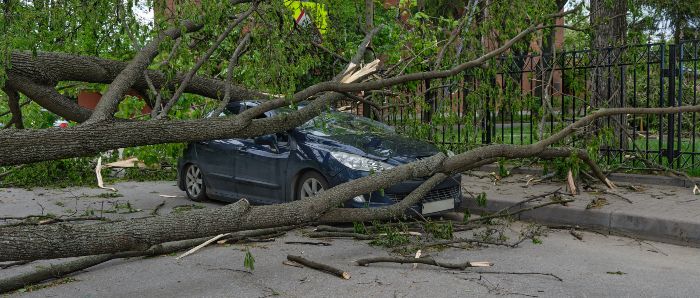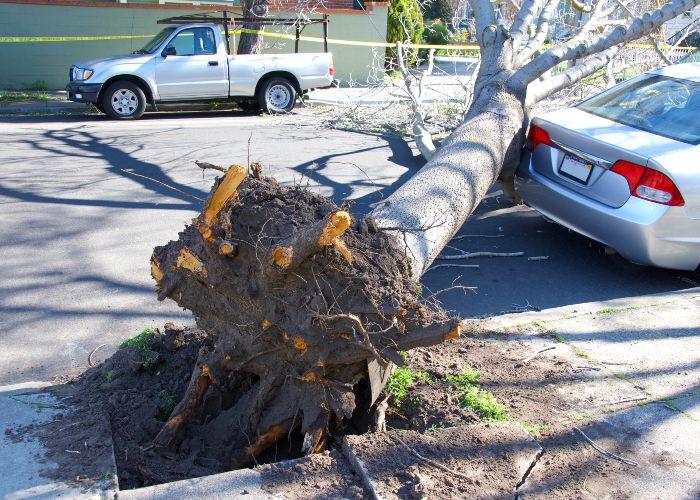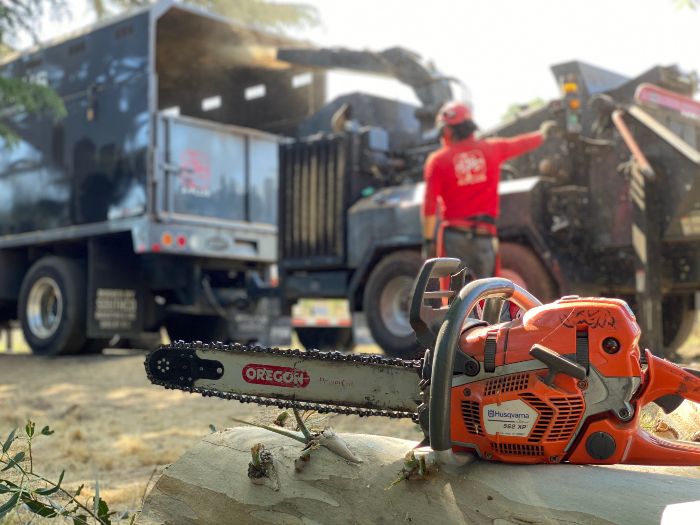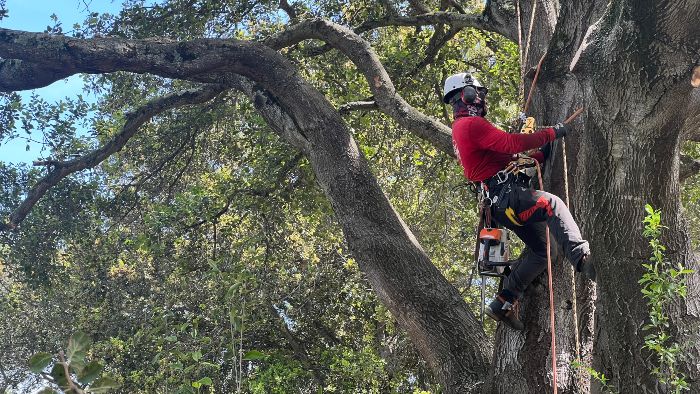A sudden crash, the crunch of metal, and the splintering of wood—having a tree fall on your car is not only startling but can also lead to major financial and legal concerns. Who is responsible? And what should you do? Navigating all the steps can be confusing and stressful. Read on to learn more about the various scenarios involving fallen trees and cars, what kind of insurance covers such damages, and what to do if it happens to you.
Types of Fallen Tree Damage
Understanding the different scenarios in which a tree might fall is the first step. The responsibility and the steps you need to take can vary greatly depending on who owns the tree and where it falls. Here are some common situations:
- Your tree falls on your car.
- Your tree falls on your neighbor’s car.
- Your neighbor’s tree falls on your car.
- You hit a fallen tree in the road.
- A city-owned tree falls on your car.

1. Your Tree Falls on Your Car
If a tree on your property falls on your car, the responsibility generally falls on you. Homeowners insurance typically covers damage to your house and other structures on your property, but not your car. In this case, you will need to rely on your car insurance to cover the damages. Comprehensive car insurance is the specific type of coverage that will handle fallen tree damage. If you have comprehensive coverage, your insurance should cover the repair costs after you pay your deductible.
2. Your Tree Falls on Your Neighbor’s Car
When your tree falls on your neighbor’s car, the situation can become a bit more complex. Generally, if the tree was healthy and fell due to an act of nature (such as a storm), your neighbor’s car insurance should cover the damage through their comprehensive coverage. However, if the tree was dead or diseased and you neglected to take it down despite being aware of its condition, you might be held liable for the damages. In such cases, your homeowner’s insurance might be required to cover the costs. It’s always wise to communicate openly with your neighbor and involve your insurance companies to sort out the responsibilities.
3. Your Neighbor’s Tree Falls on Your Car
If your neighbor’s tree falls on your car, your comprehensive car insurance will typically cover the damage. Similar to the previous scenario, if the tree was healthy, it’s considered an act of nature, and your insurance should handle it. However, if the tree was dead or diseased and your neighbor was aware but did nothing about it, you might be able to claim damages through their homeowner’s insurance. Documentation and proof of negligence will be key in such cases.
4. Hitting a Fallen Tree in the Road
Collisions with fallen trees on the road can also result in significant damage to your car. In this scenario, comprehensive car insurance is again your go-to coverage. If the tree fell recently and was not yet reported or cleared by local authorities, it’s considered an unavoidable accident. However, if the tree has been there for a while and the authorities were negligent in removing it, you might have grounds to claim damages from the city or town responsible for the road maintenance. Document the scene thoroughly and report the incident to the authorities and your insurance company as soon as possible.
5. A City-Owned Tree Falls on Your Car
When a tree owned by the city or town falls on your car, determining liability can be challenging. Typically, if the tree was healthy and fell due to a storm or other natural causes, your comprehensive car insurance will cover the damage. However, if the tree was dead or diseased and the city had been negligent in maintaining it, you might have a claim against the city. Filing such claims can be complex and may require legal assistance. It’s crucial to document the incident, gather evidence of the tree’s condition, and consult with your insurance company and possibly a lawyer.

What Kind of Car Insurance Covers Damages from a Fallen Tree?
Comprehensive car insurance is the specific type of coverage that protects against fallen tree damage. This type of insurance covers damages to your car that are not caused by a collision, such as theft, vandalism, natural disasters, and falling objects, including trees. If you only have liability or collision coverage, you won’t be covered for damages caused by a fallen tree. Review your insurance policy and consider adding comprehensive coverage if you don’t already have it, especially if you live in an area with many trees or severe weather conditions.
What Do I Do with the Damaged and Fallen Tree?
First and foremost, make sure everyone is safe and block off any hazardous areas with cones, signs, or caution tape. After ensuring everyone’s safety and reporting the incident to your insurance company, address the fallen tree itself. Here are the steps you should follow:
- Document the damage: Take photos and videos of the scene from multiple angles. This documentation will be useful for your insurance claim.
- Remove the tree: Contact a professional tree removal service for safe and efficient tree removal. If the fallen tree is in a condition or location that poses hazards, consider emergency tree removal to immediately have the tree taken care of. Do not attempt to remove large trees or those entangled with power lines yourself because you may cause harm to structures or worse, yourself!
- Temporary fixes: If the fallen tree has left your car exposed to the elements, consider temporary fixes like tarps to protect it from further damage until repairs can be made.
- Claim process: Work closely with your insurance company throughout the claims process, providing all necessary documentation and following their instructions for repairs and reimbursement.

How Can I Prevent a Tree from Falling?
Preventative measures can save you from the hassle and expense of dealing with fallen trees. Here are some tips to help you maintain your trees and reduce the risk of them falling:
- Regular inspections: Have your trees inspected by a certified arborist regularly to identify any signs of disease, decay, or structural issues.
- Prune regularly: Proper pruning can remove dead or weak branches, reducing the weight and wind resistance of the tree.
- Remove hazardous trees: If a tree is dead, diseased, or structurally compromised, have it removed before it becomes a hazard.
- Proper watering and fertilization: Ensure your trees receive adequate water and nutrients to maintain their health and stability.
- Install supports: In some cases, installing cables or braces can provide additional support to trees with weak branches or multiple trunks.
By taking these proactive steps, you can minimize the risk of tree-related damage to your property and vehicles.






